Econ flashcards
1/98
There's no tags or description
Looks like no tags are added yet.
Name | Mastery | Learn | Test | Matching | Spaced |
|---|
No study sessions yet.
99 Terms
positive statement
easy to prove, factual
normative statement
no right answer, often political
self interest
Economics assumes humans operate in their own self interest
invisible hand
our self interested acts typically result in socially constructed transitions
opportunopprotunityty cost
the loss of potential gain from other alternatives when one alternative chosen
rational choice
mb > bc - do; mb <mc - dont; mb=mc - indifferent, do
sunk cost
a cost paid you cannot get back - this should not be a factor in decision making
resources
land, labor, capital
land = natural resources, capital - machines and productive resources
money is not a resource it is not productive in se
production possibilities frontier
shows all possible combinations of an output that can be produced assuming
a fixed amount of productive resources at a given quantity
efficient use of those resources
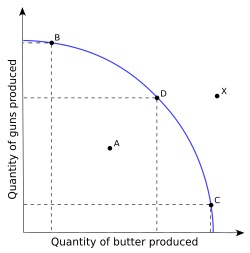
direct costs
out of pocket costs
indirect costs
opportunity costs, often a value and not monetary
law of demand
there is an inverse relationship between price and quantity demanded
If the price of milk decreases, the quantity people will buy increases
demand curve
a graph that shows the relationship between the price of a good and the quantity demanded at various prices.
Demand curve can shift to the left or right, a decrease in demand shifts to the elft while an increase in demand shifts to the right
If the graph follows the curve downard, thats a change in quantity demanded
If the graph shifts along the x axis but remains constant on the y axis, that is a change in demand
Demand stays the same but quantity demanded increases when the price decreases
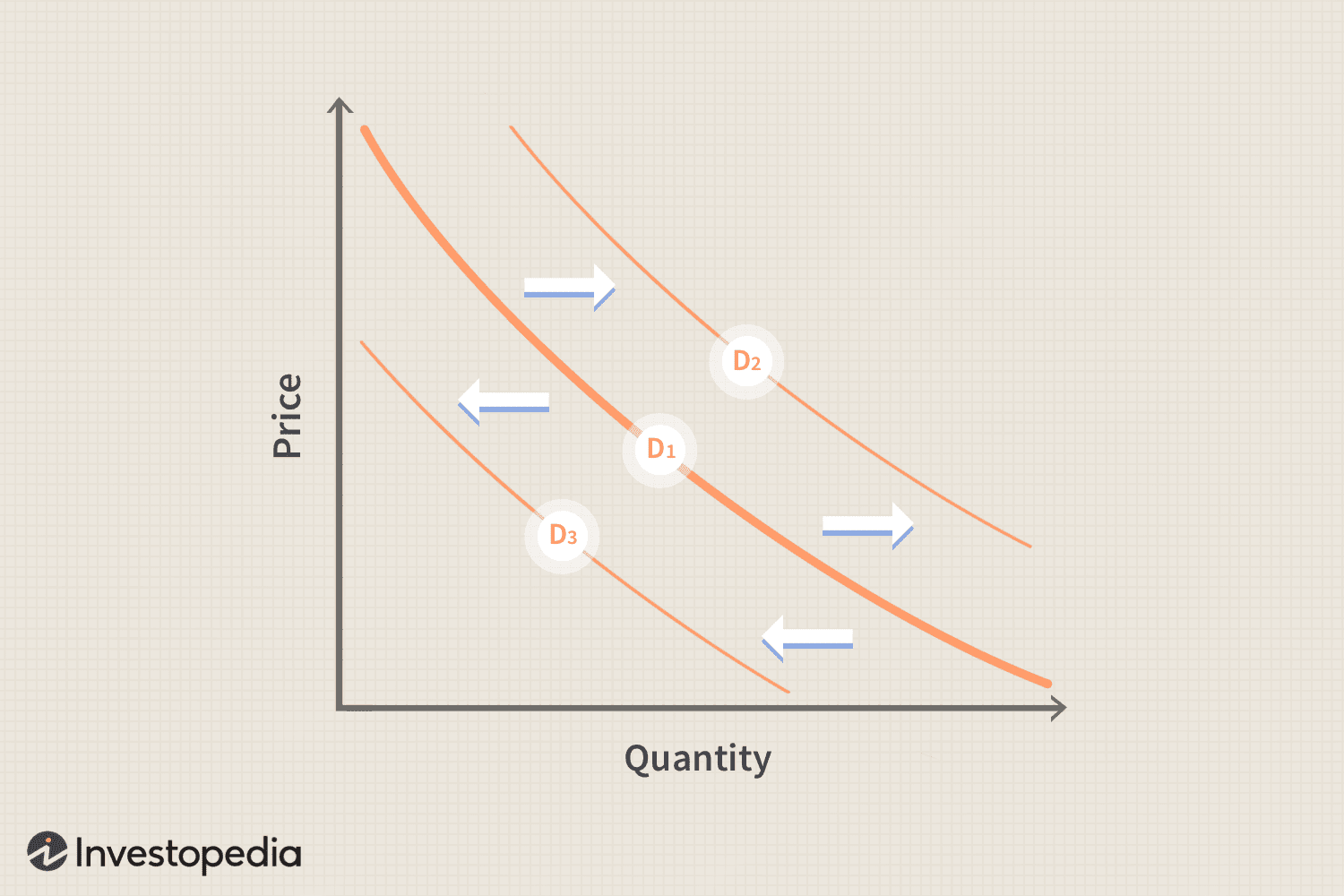
substitution effect
Chances in price motivate consumers to buy relatively cheaper substitutes goods
income effect
Changes in price affect the purchasing power of consumers’ income
law of diminishing marginal utility
As you continue to consume a given product, you will eventually get less additional utility (satisfaction) from each unit you consume
5 shifters of demand
Tastes and preferences
Number of consumers
Price of related goods (substitutes and compliments)
Substitute is a good you use in place of the original
A complement is a good you use along with the original good
Income
Normal goods - income and the demand for the product are directly related
inferior goods - income and the demand for the product are inversely related
Expectations
normal goods
income and the demand for the product are directly related
inferior goods
income and the demand for the product are inversely related
law of supply
Law of supply - there is a direct relationship between price and quantity supplied
When the price goes up for milk, the quantity produced will increase
When the price increases only the quantity supplied increases (moves along the curve) while the 5 shifters change the supply (moves curve)
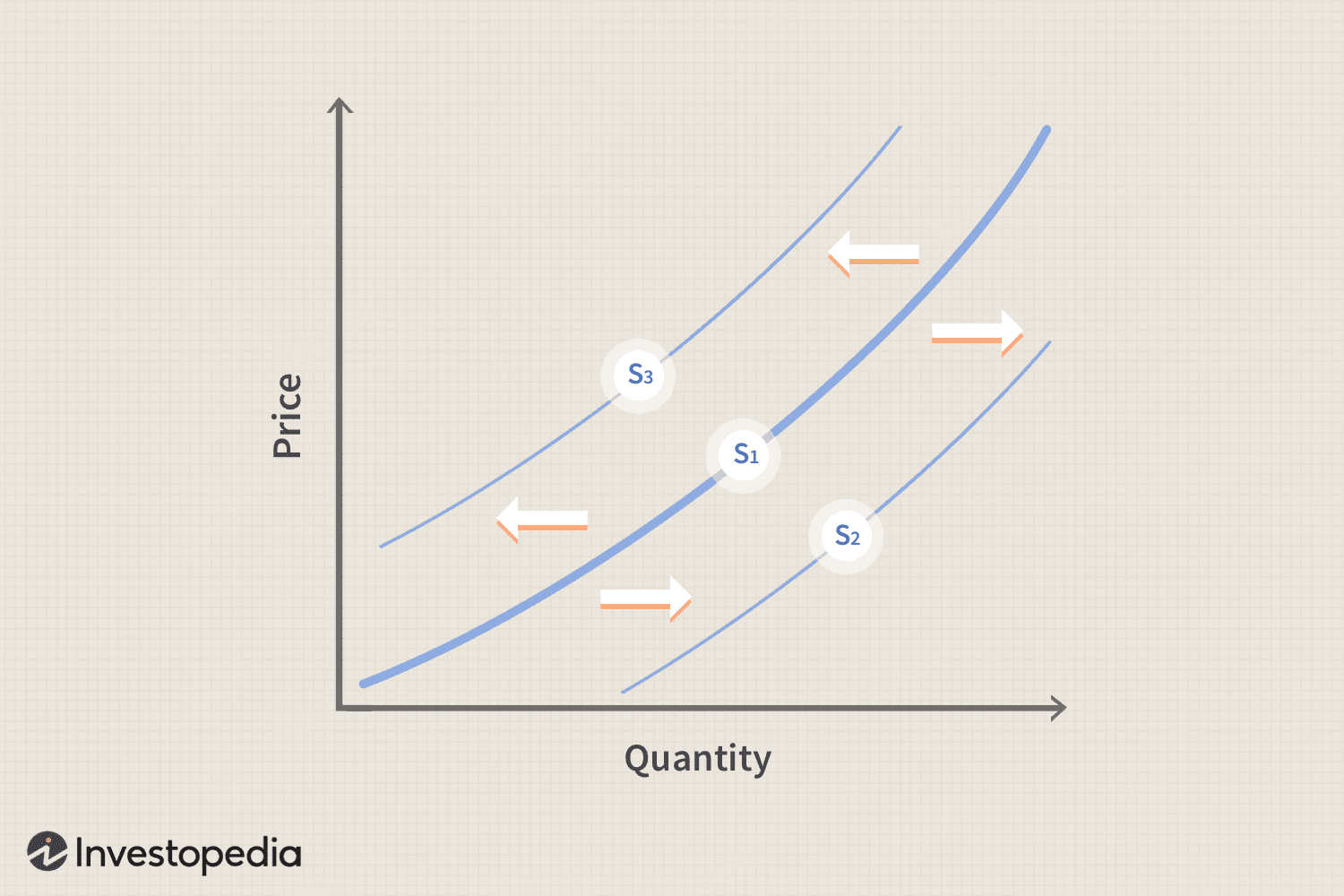
5 shifters of supply
Price of resources - changes in prices of inputs (cheaper cows - more milk)
Number of producers
Technology - milking machines = increase supply
Taxes and subsidies - if gov gives subsidies, supply curve shift to right, while taxes shift to left
Expectations
market equilibrium
Market equilibrium - where the supply and demand curves converge to determine price and quantity
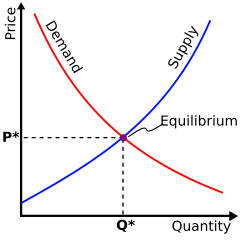
disequilibrium
leads to a surplus when the quantity supplied is higher than the quantity demanded (upper region)
also leads to a shortage when the quantity demanded is higher than the quantity supplied
price ceilings
lie below the intersection of the supply and demand curve
Purpose is to prevent the price from rising above a certain level
excess demand
at a cheaper price consumers have more of an incentive to consume and producers have less of an incentive to produce, leading to an excess of demand
allocation problems
if goods are not allocated by price, allocation becomes a more first come first serve basis. Causing one to pay time in exchange for a decreased price
black markets
allows criminal organizations to gain power by controlling underground markets—making trades that are otherwise prohibited by the government
corruption
political connections are powerful, allowing politicians to acquire the goods for themselves and their friends
policing costs
the government would need to expand resources to combat lack markets, increasing opportunity costs. If government officials are benefitting from the law, they have an incentive to crack down on their black market competitors
decline in quality
producers have an incentive to cut costs, especially since they are making less of a profit. Thus, they may water down their milk or add substitutes. Declining the quality of the product they produce intentionally
targeting
price ceilings affect everyone. While intended to help the poor, the wealthy have an increased access to it and probably end up getting the goods more than the poor regardless
rigid/inflexible pricing
free market prices adjust to changing conditions, allowing prices to serve as a signal. Governments tend to be slow in reacting to changes, causing price ceilings to take a long time to change and may not adapt to evolving supply and demand conditions
lack of transparency
cost of price controls are hard to assess and measure because they are often unexpected and volatile. Making efficacy hard to determine.
prices send signals
if the price on something rises it is because there is a higher demand relative to supply
Decreasing the price would just make the supply problem worse
Price controls kill the messenger
Bidding up price vs bidding up time
During the 70s the widespread price ceiling led to an economic freeze because everything was out and a literal freeze
Farmers drowned a bunch of baby chicks
Higher prices give consumers incentive to conserve and thus free some up for others
rent control
price ceiling on rents designed to provide affordable housing for the poor
Economists are not against the goals of rent control but the unpredicted consequences it tends to come with
If landlords cannot afford to pay the taxes of their property due to rent control, they also cannot pay for repairs or maintenance - buildings collapsing in mumbai
economical rent support
giving money to a target population, such as a housing voucher to ensure its spent on housing and increases demand directly
advantages of housing vouchers
Providing income to consumers - a demand subsidy - will shift the demand curve to the right
Housing vouchers are provided through tax returns
Incentive to build more rental housing units - by stimulating demand it encourages supply
Avoids black markets, policing costs, tenant-landlord litigation, and quality problems
Transparency
Sharing the burden
Price message is still heard

production subsidies
To subsidize the construction of affordable housing
“Low income housing tax credit”
Increases supply by lowering production cost for producers
Creates a wedge between price consumers pay and the price producers get
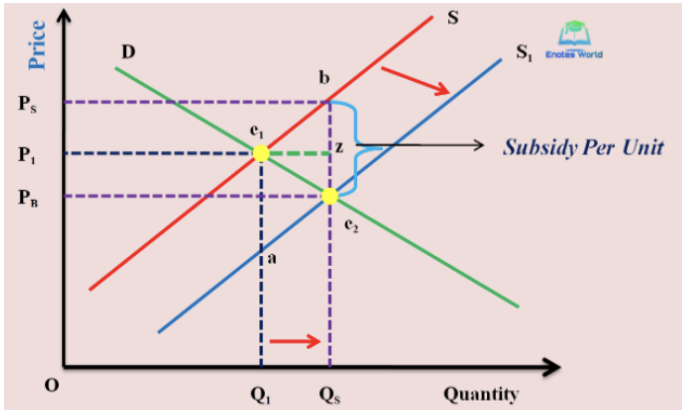
zoning restrictions
governmental restrictions of what can be built on the land
housing problems in the US
Mortgage rates are decreasing, but homes built are not increasing—In fact, theyre at an all time low
Exclusionary zoning makes it even more difficult to build homes
The laws dont explicitly mention race, but they continue to influence segregation
price floors
attempt to keep prices above the equilibrium price
Intended to help producers by keeping prices high
Minimum wages and agricultural farm support programs
The cost of the policy are spread out among millions of consumers while the benefits are concentrated on a small group of people
excess due to price floors
Throw it away
Save it up (just to throw it away when it goes bad)
Government cheese
Use it for the military or school lunches
Let the price fall while maintaining the target price (taxes go towards the difference
Sell it abroad
Give it away as food aid to developing countries
Tanks the agricultural sector of those countries
pure capitalism
private ownership of resources - private property of land labor and capital
prices free to adjuist
resources free to flow
firms produce to make a profit
decentralized decision making
command socialism
state ownership of resources
prices controlled by state planners
resource allocation by state planners
firms produce to meet a quota
centralized decision making
government owns all resources and production
under communism
the government disappears and there is economic cooperation as well. The principle of distribution becomes “from each according to his/her ability, to each according to his/her need”
two fundamental problems for command socialism
Incentives - a lack of incentives leads to a lack of production
Lack of knowledge - without a system of working prices the relative values of resources are unknowable
Politicians do not bet their own money when campaigning and making policy, they bet taxpayer money
socialism
market economies with a high preference for income equality
social democracy
seeks to modify capitalism
democratic socialists
seek to replace capitalism with a decentralized socialist ownership structure
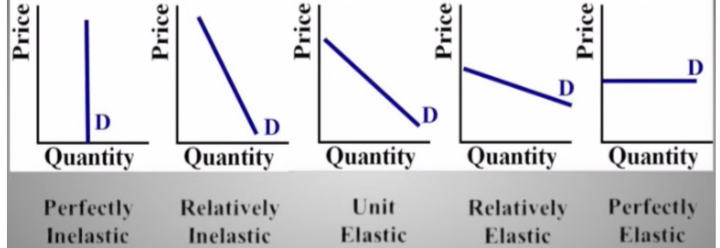
elasticity of demand
measures how sensitive quantity demanded is to a change in price
inelastic demand
the quantity is insensitive to the change in price
Products that are inelastic have very few substitutes
Price goes up, total revenue goes up
Price goes down, total revenue goes down
When change is = 1 , unit elastic demand
elasticity coefficient less than 1
elastic demand
quantity is sensitive to a change in price
Many substitutes
Elasticity coefficient greater than 1
Price goes up, total revenue goes down
Price goes down, total revenue goes up
perfectly inelastic
quantity demanded does not change for price, it remains constant
midpoint formula
ped = (q2-q1/(q1+q2)/2)/(p2-p1/(p1+p2)/2)
price elasticity of supply determinants
When we are more horizontal (flatter the supply curve) - relative elasticity
For inelastic
Short run
Not a lot of available resources
For elastic
Long run
Arent resource constrained
price elasticity of supply
Calculates how responsive quantity supplied is to a change in price
% change in quantity supplied/ % change in price
Supply elasticity will be greater the easier it is for producers to acquire the resources needed to produce the good in question
Goods needing specialized input will tend to be more inelastic than goods that do not need a specialized input
income elasticity of demand
How responsive demand is to a change in income
Positive for normal goods
Negative for inferior goods
Luxury good > 1 > necessity
All luxury goods are normal goods, but not are normal goods are luxury goods
cross price elasticity of demand
How responsive demand for good x is to a change in the price of good y
Positive for substitutes
Negative for complements
the labor market
For the labor market - the supply is the amount of labor available (workers) while the demand is coming from employers
When new labor comes into the country, it has no necessary effect on wages in general (although it can be focused on other low skilled labor). But these individuals are also driving up demand for food, clothes, and other things, so it evens out
in favor of minimum wage
minimum wage has not been risen since 2009
A “starvaton wage”
Treating workers decently is worth the price
Increase in minimum wage does not reduce the number of jobs
A higher minimum wage can actually lower costs for small business
The choice leads to higher productivity, better service, etc
A majority of workers who received a wage increase improved their performance
Employee turnover decreased by 34%
For every10% increase in the minimum wage, prices increased by less than half of the percent (and this is a temporary increase!)
Raising the minimum wage would decrease the taxes spent on public assistance
Will reduce racial and gender paid disparities
Low minimum wage is harming people in their prime working years
Good for workers, good for businesses, good for the economy
against minimum wage
May reduce employment - depends on the price elasticity of demand for labor
If higher wages are good for a business then they would do that on their own - a government mandate is not required
earned income tax credit
the program where the government provides extra income for work
Based on annual income earned and size of family
income subsidies over minimum wage
Incentivising - creates the incentive to hire workers instead of firing them. The subsidy is paid by taxpayers not by employers - thus encouraging a greater hiring of labor
Targeting - goes to low income families. Provides those with more dependents a larger subsidies. Minimum wage does not adjust for how many dependent there are
Transparency - the whole program is transparent and we can see that the programs work and then argue about the size
Sharing the burden - its covered by all taxpayers instead of just employers
marginal benefit
the additional benefit arising from a unit increase in a particular activity
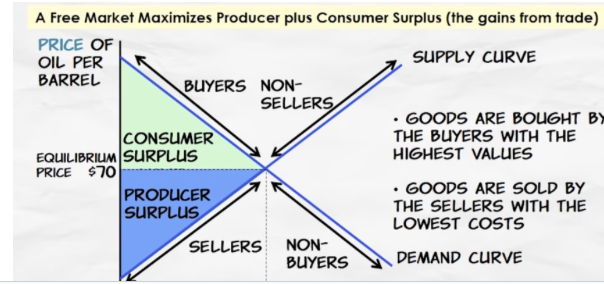
consumer surplus
consumers gain from exchange - the difference between the maximum price a consumer is willing to pay for a quantity vs the price they actually have to pay
The area beneath the demand curve and above the price on a graph
½(base x height)
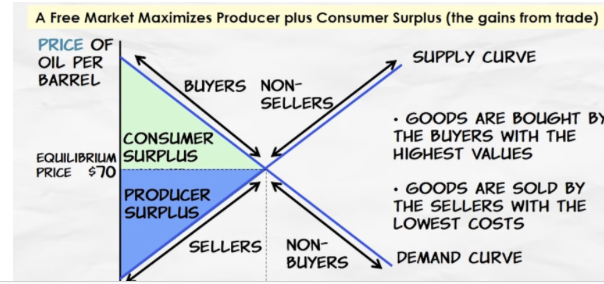
producer surplus
producers gain from exchange. The difference between the market price and the minimum price at which producers would be willing to sell a given quantity
The sum of the producer surplus of each seller is total producer surplus
Measured by the area above the supply curve and below the price
free market equilibrium
Equilibrium price is the only stable price
For any quantity below the equilibrium quantity there are unexploited gains from trade
The equilibrium quantity = all gains from trade exploited
For any quantity above the equilibrium quantity there is waste
A free market maximises the gains from trade (consumer and producer surplus)
Goods are bought by the buyers that value them the most
Goods are sold by the sellers with the lowest cost
The supply of goods is bought by the buyers with the highest willingness to pay
The supply of goods are sold by the seller with the lowest costs
Between buyers and sellers there are no unexploited gains from trade or any wasteful trades
excise tax
tax on producers of a specific good
The consumers and producers both pay a portion of the tax
calculating tax
Vertical distance between price and new price tells us the per unit amount of tax
Consumer and producer surplus decreases
total tax revenue
tax x quantity demanded
tax paid by consumers
change in consumer price x quantity demanded
tax paid by producers
total tax revenue - total amount paid by producers
total expenditures
new price x quantity demanded
total revenue to firms
total expenditures - total tax revenue = producer takeaway
taxes and elasticity
For inelastic goods, consumers will end up bearing more of the tax burden because as the price rises consumers do not shift away from the product
If supply and demand have identical elasticities then the burden is shared equally
Excise taxes on goods with relatively inelastic demand results in less distortion and more tax revenue for the government
eitc and minimum wage
Price controls tend to work against arket forces and tend to come with more unintended consequences than market friendly interventions (taxes and subsidies)
EITC is a production subsidy in which workers supply labor
Market friendly policies tend to lead to greater transparency, better targeting, less corruption, lower policing costs, fewer lawsuits, and a shared burden
means tested
assistance is targeted to a certain group - typically low income households
assistance prograsm: housing vouchers, food stamps, medicaid, temporary assistance for needy families, unemployment benefits, pell grants etc
entitlements
if you qualify then the government will give it to you
Incentive to not work so you qualify for a government subsidy?
A lower BRR (benefit reduction rate) increases work incentives but will increase the cost of the program
The extra income earned reduces benefits from each program
Families are in some sense trapped in poverty
Universal basic income
Government progvides everyone a basic monthly income
market failures
occur when the free unregulated market produces a result that is not optimal
Comes in positive externalities, negative externalities, common property goods, public goods, information failures, and insufficient competition
negative externalities
when actions by one party force others to suffer a consequence
You do not need to have the sale of a good to have an externality
marginal private cost
the internal costs considered in supply curves such as labor, power, machines, etc.
Free market outcome
marginal external costs
externalities that fall on other parties rather than the company
Imposes costs on anyone not involved in the decision making
Marginal social costs
the combination of marginal private cost and external costs, all costs are considered
The total cost to all members of society
marginal social benefit
area e is the degree to which the free market results in a less than optimal outcome
Government solutions to negative externalities
Internalize the externalize costs
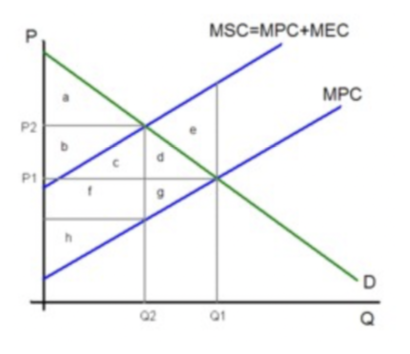
postive ecternalties
choices that result in the benefits of others
Social benefits exceed private benefits
Gov solution - internalize the external effect
Gov needs to make the decision more beneficial to the private decision maker
As you decrease costs, the marginal benefit of decreasing it more decreases
We dont equally accrue benefits and we dont all equally play the cost of pollution reduction
correcting for externalities
Voluntary action - moral suasion - educat and encourage people to “do the right thing”
Command and control - government sets a law or regulation
Tax negative externalities/subsidize positive externalities
Marketable (like pollution) permits for dealing with some negative externalities
Permits that give you the right to pollute
non-exclusive competition
once a good is provided it is difficult or impossible to restrict access to it based on whether someone has paid for it or not